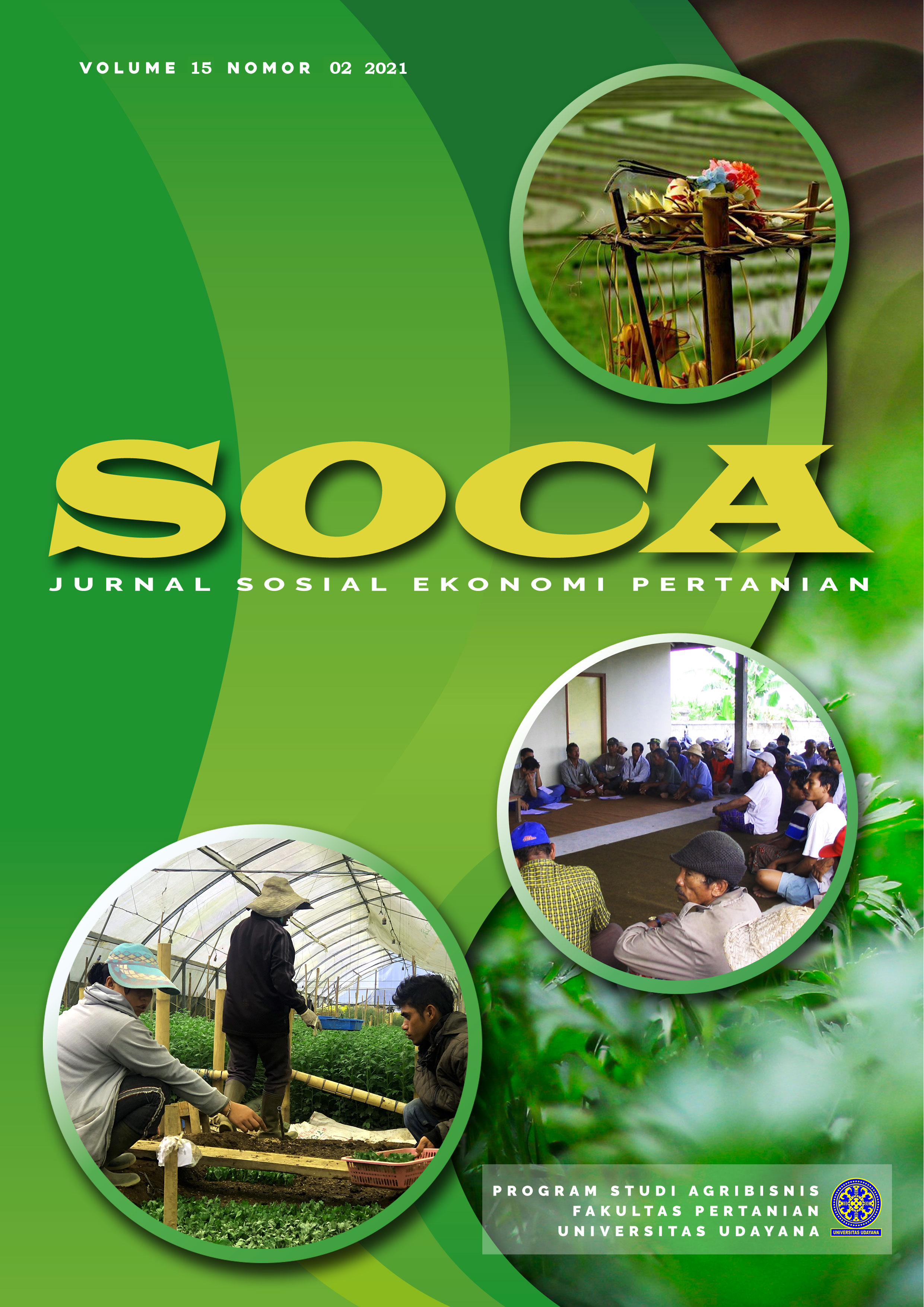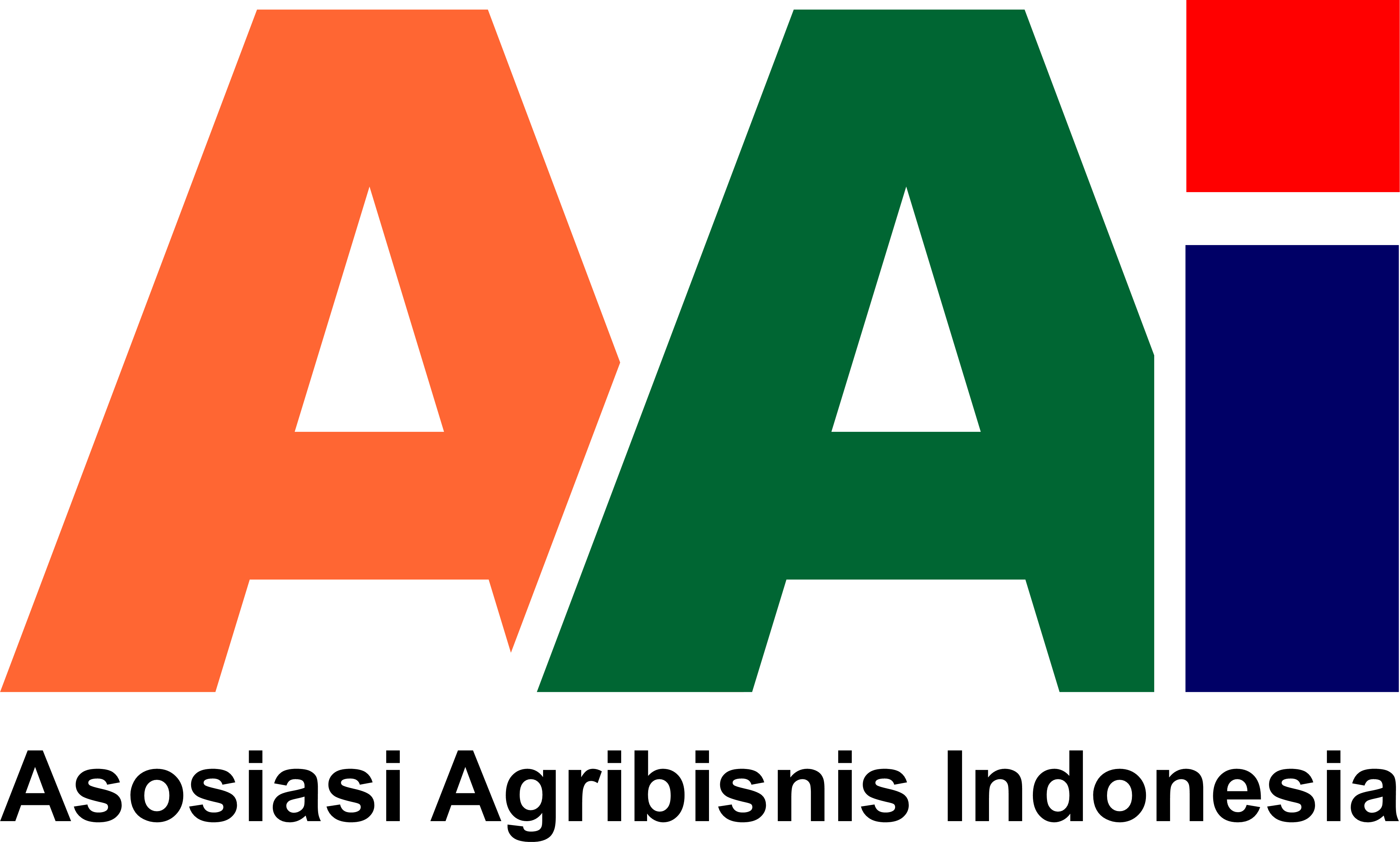Rice Import Development in Indonesia
Abstract
Rice consumption in Indonesia has risen as the population increasing rapidly. The structure of the young age population will influence the amount of per capita of rice consumption. The rice cultivating and production will also determine whether or not it will fulfil the needs. The present research aimed at analyzing Indonesian rice import within the last decade (2010 – 2019). The research method used was a literature review. The research result shows that within the last 10 years, the width of the rice cultivating and production area have been declining as much as 1,8% and 1.6% respectively. However, the rice productivity rate is still in positive number at 2.0%. Eventhough the household consumption declined as much as 2% annually, apparently this was not enough for Indonesia to fulfil the needs internally. In short term period, an import would be a solution to fulfil the needs for domestic rice consumption. On the other hand, for a longer term, an import can be a problem because the rice trade balance with be disrupted. A small number of rice export volume will result in a rice trade balance deficit in Indonesia.
Downloads
References
Alan, M. F. (2019). Kebijakan Impor Beras di Indonesia. Yuridis, Vol. 6, No.1, pp 24–45.
Boateng, K. K., Obeng, G. Y., and Mensah, E. 2017. Rice Cultivation and Greenhouse Gas Emissions: A Review and Conceptual Framework with Reference to Ghana. Agriculture Vol. 7, No.7, pp 1-14.
BPS. (2017). Statistik Indonesia 2017. In Katalog: 1101001 (p 750). Badan Pusat Statistik. http://library1.nida.ac.th/termpaper6/sd/2554/19755.pdf
BPS. (2018). Statistik Indonesia 2018. In Katalog: 1101001. Badan Pusat Statistik. http://library1.nida.ac.th/termpaper6/sd/2554/19755.pdf
BPS. (2019). Produksi Padi menurut Provinsi 2014-2018. In Katalog, Vol. 2, No. 196, p. 354). Badan Pusat Statistik.
BPS. (2020). Data Sosial Ekonomi (125 Ocktober). Badan Pusat Statistik.
Chaudhari, P.R., Tamrakar, N., Singh, L., Tandon, A., and Sharma, D. 2018. Rice nutritional and medicinal properties: A review article. Journal of Pharmacognosy and Phytochemistry Vol. 7, No.2, pp 150-156.
Coulibaly, J. Y., Tebila, N., and Diagne, A. (2015). Reducing rice imports in Côte d’Ivoire: Is a rise in import tariff the solution?. Agricultural and Resource Economics Review, Vol. 44 No. 3, pp 195–213. https://doi.org/10.1017/S1068280500005025
Davidson, J. S. (2018). Rice imports and electoral proximity: The Philippines and indonesia compared. Pacific Affairs, Vol. 91, No. 3, pp 445–470. https://doi.org/10.5509/2018923445.
Demont, M., and Rizzotto, A. C. (2012). Policy Sequencing and the Development of Rice Value Chains in Senegal. Development Policy Review, Vol. 30, No. 4, pp 451–472. https://doi.org/10.1111/j.1467-7679.2012.00584.x.
Doumbia, D., Van Paassen, A., Oosting, S. J., and Van Der Zijpp, A. J. (2012). Livestock in the rice-based economy of Office du Niger: The development potential for increased crop-livestock integration through multi-actor processes. NJAS - Wageningen Journal of Life Sciences, 60–63, 101–114. https://doi.org/10.1016/j.njas.2012.07.002
Fulton, M. E., and Reynolds, T. (2015). The political economy of food price volatility: The case of Vietnam and Rice. American Journal of Agricultural Economics, 97(4), 1206–1226. https://doi.org/10.1093/ajae/aav019
Gao, Q., Ito, S., Ogundari, K., and Saito, H. (2016). Evaluating welfare effects of rice import quota in Japan: Based on measuring non-tariffbarriers of SBS rice imports. Sustainability (Switzerland), Vol. 8, No. 8. https://doi.org/10.3390/su8080817.
Giesecke, J. A., Tran, N. H., Corong, E. L., and Jaffee, S. (2013). Rice Land Designation Policy in Vietnam and the Implications of Policy Reform for Food Security and Economic Welfare. Journal of Development Studies, Vol. 49 No. 9, pp 1202–1218. https://doi.org/10.1080/00220388.2013.777705
Kemendag. (2014). Analisis Outlook pangan 2015-2019. Pusat Kebijakan Perdagangan Dalam Negeri Badan Pengkajian Dan Pengembangan Kebijakan Perdagangan Kementerian Perdagangan. http://bppp.kemendag.go.id/media_content/ 2017/08/Analisis_Outlook_Pangan_2015-2019.pdf
Kemendag. (2019). Analisis Perkembangan Harga Bahan Pangan Pokok di Pasar Domestik dan Internasional (p. 118). Pusat Pengkajian Perdagangan Dalam Negeri , Badan Pengkajian dan Pengembangan Perdagangan, kemeterian perdagangan Republik Indonesia.
Kementan. (2016). Outlook Komoditas Pertanian Sub Sektor Tanaman Pangan. Pusat Data dan Sistem Informasi Pertanian, Kementerian Pertanian. http://library1.nida.ac.th/termpaper6 /sd/2554/19755.pdf
Kusumah, F. P. (2019). Ekonomi Politik dalam Kebijakan Impor Beras: MembacaArah Kebijakan Pemerintah 2014-2019. Politika: Jurnal Ilmu Politik, Vol. 10, No. 2, p 137. https://doi.org/10.14710/politika.10.2.2019.135-156
Mushtaq, S., Cockfield, G., White, N., and Jakeman, G. (2014). Modelling interactions between farm-level structural adjustment and a regional economy: A case of the Australian rice industry. Agricultural Systems, Vol. 123, pp. 34–42. https://doi.org/10.1016/j.agsy.2013.08.010
Nuryanti, S., Hakim, D. B., Siregar, H., and Sawit, M. H. (2018). Political Economic Analysis of Rice Self-Sufficiency in Indonesia. Indonesian Journal of Agricultural Science, Vol. 18, No. 2, p 77. https://doi.org/10.21082/ijas.v18n2.2017.p77-86
Panuju, D. R., Mizuno, K., and Trisasongko, B. H. (2013). The dynamics of rice production in Indonesia 1961–2009. Journal of the Saudi Society of Agricultural Sciences, Vol. 12, No. 1, pp 27–37. https://doi.org/10.1016/j.jssas.2012.05.002
Pudjiastuti, A. Q. (2014). Perubahan Neraca Perdagangan Indonesia Sebagai Akibat Penghapusan Tarif Impor Gula. Agriekonomika, Vol. 3, No. 2, pp 106–116.
Pudjiastuti, A. Q., Anindita, R., Nuhfil, H., and Kaluge, D. (2013). Changes Effect Of Sugar Import Tariff In Indonesia. Russian Journal of Agricultural and Socio-Economic Sciences, Vol. 3, No. 15, pp 31–38. https://doi.org/10.18334/np3499
Pudjiastuti, A. Q., and Kembauw, E. (2018). Sugar Price Policy and Indonesia’s Trade Balance. Journal of Advanced Research in Law and Economics, Vol. 8, No. 8. https://doi.org/10.14505/jarle.v8.8(30).26
Purwanto, N. P. (2019). Upaya Antisipasi Gejolak Harga Beras di Akhir Tahun 2019. Info Singkat, Vol. 11, No. 20, pp 19–24.
Rachman, B., Agustian, A., Syaifudin, A., and Tentara. (2019). Implications of Rice Ceiling Price Policy to Paddy Farming Profitability and. Analisis Kebijakan Pertanian, Vol. 17, No. 1, pp 59–77. http://www.ejurnal.litbang.pertanian.go.id/ index.php/akp/article/download/9542/8471
Rakotoarisoa, M. A. (2011). The impact of agricultural policy distortions on the productivity gap: Evidence from rice production. Food Policy, Vol. 36, No. 2, pp 147–157. https://doi.org/10.1016/j.foodpol.2010.10.004
Rowell, C., Kuiper, N., Al-Saad, K., Nriagu, J., and Shomar, B. (2014). A market basket survey of As, Zn and Se in rice imports in Qatar: Health implications. Food and Chemical Toxicology, Vol. 70, May, pp 33–39. https://doi.org/10.1016/j.fct.2014.04.041
Scott, M. J., Daly, D. S., Zhou, Y., Rice, J. S., Patel, P. L., McJeon, H. C., Page Kyle, G., Kim, S. H., Eom, J., and Clarke, L. E. (2014). Evaluating sub-national building-energy efficiency policy options under uncertainty: Efficient sensitivity testing of alternative climate, technological, and socioeconomic futures in a regional integrated-assessment model. Energy Economics, Vol. 43, pp 22–33. https://doi.org/10.1016/ j.eneco.2014.01.012
Short, C., Barreiro-Hurle, J., and Balié, J. (2014). Policy or Markets? An Analysis of Price Incentives and Disincentives for Rice and Cotton in Selected African Countries. Canadian Journal of Agricultural Economics, Vol. 62, No. 4, pp 441–469. https://doi.org/10.1111/cjag.12049
Singh, S., Singh, T. N., and Chauhan, J. S. (2011). Living with limited water, part II: Dynamics of leaf rolling, leaf water homeostasis and water economy by hybrid rice. Journal of Crop Improvement, Vol. 25, No. 4, pp 435–457. https://doi.org/10.1080/15427528.2011.583559
Siswanto, E., Marulitua Sinaga, B., and Harianto, . (2018). The Impact of Rice Policy on Rice Market and The Welfare of Rice Producers and Consumers in Indonesia. Jurnal Ilmu Pertanian Indonesia, Vol. 23, No. 2, pp 93–100. https://doi.org/10.18343/jipi.23.2.93
Sugiyanto, C. (2006). Permintaan Beras Di Indonesia: Revisited. Jurnal Ekonomi Dan Bisnis Indonesia, Vol. 21, No. 2, pp 138–155. https://doi.org/10.22146/jieb.6501
Takahashi, D. (2012). The distributional effect of the rice policy in Japan, 1986-2010. Food Policy, Vol. 37, No.6, pp 679–689. https://doi.org/10.1016/j.foodpol.2012.07.008
Tey, J. Y.-S., and Radam, A. (2011). Demand patterns of rice imports in Malaysia: Implications for food security. Food Security, Vol. 3, No. 2, pp 253–261. https://doi.org/10.1007/s12571-011-0128-1
Tey, Y. S., and Brindal, M. (2013). Adapting importation policy to global commodity markets: implications of rice import allocation in Singapore. Mitigation and Adaptation Strategies for Global Change, 19(8), 1277–1293. https://doi.org/10.1007/s11027-013-9474-y
Xie, S. and Artachinda, O. N. 2014. Review of Rice Policies in China, Thailand and Vietnam. ARE Working Paper No. 2557/1. Department of Agricultural and Resource Economics, Faculty of Economics, Kasetsart University, Bangkok.
Yanuarti, A. R., and Afsari, M. D. (2016). Profil Komoditas Barang Kebutuhan Pokok dan barang Penting: Komoditas Beras. Direktorat Jenderal Perdagangan Dalam Negeri Kementerian Perdagangan Pengarah.
Yap, C. L. (1996). Implications of the Uruguay Round on the world rice economy. Food Policy, 21(4-5 SPEC. ISS.), 377–391. https://doi.org/10.1016/0306-9192(96)00014-0
Zader, A. (2012). Understanding quality food through cultural economy: The “politics of quality” in China’s northeast japonica rice. Agriculture and Human Values, Vol. 29, No. 1, pp 53–63. https://doi.org/10.1007/s10460-011-9316-z
Zheng, H., Huang, H., Li, D., Li, X., Fu, Z., and Chen, C. (2014). Assessment of nomadic rice-duck complex ecosystem on energy and economy. Ecological Processes, Vol. 3, No. 1, pp 1–8. https://doi.org/10.1186/s13717-014-0020-y













